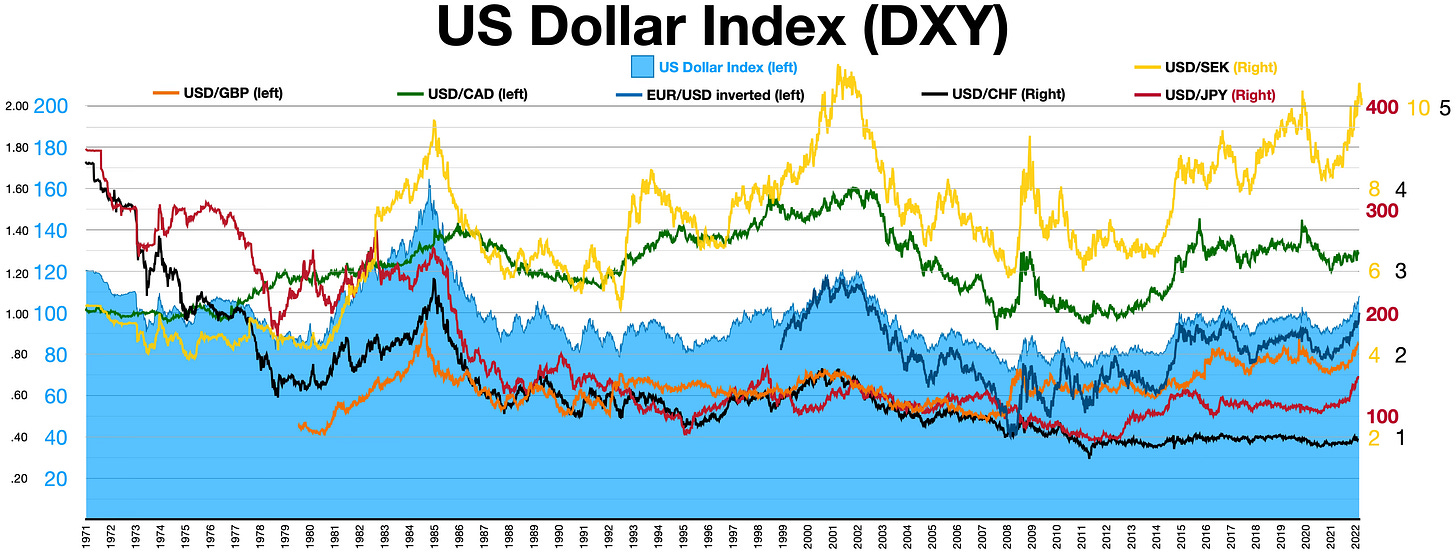An Introduction to Exchange Rates and Exchange Rate Policy
An introductory guide to understanding exchange rates through the lens of Modern Monetary Theory (MMT). Foreign trade, currency speculation, fixed and floating exchange rates, and More
“For most nations, issuing their own fiat currency under floating exchange rates, the situation is different to the days of fixed exchange rates. Since the gold window closed a different reality exists – one which, potentially at least, provides governments with significantly more scope to enact policies which benefit society (Mosler 2012)” An MMT perspective on macroeconomic policy space
What you will learn:
What an exchange rate is and why it matters; how it affects businesses, inflation, and the wider economy; the difference between fixed and floating exchange rates; why some governments shape domestic policy around their need for foreign currency; and why floating exchange rates give monetary sovereign governments more freedom to support their economies.
Technical Terms/Jargon Used in This Article
You will find definitions of all of the technical terms/jargon used in this article in my series of MMT Economic Jargon Buster articles. Paid subscribers can also download my MMT Dictionary.
Exchange Rates: More Than Just a Holiday Concern
For most people, the first time they have to deal with exchange rates is when they go on holiday. When my wife Pat and I visited New York over a decade ago, I remember going to my local bank to get dollars and looking at the exchange rate board, to find out how many dollars I was going to get for my UK pounds. It was those figures that were going to tell me just how expensive - or not - our holiday was going to be.
So, our first lesson is that the exchange rate is simply the price of one country’s currency in terms of another: in this case, it was the price of UK pounds in terms of US dollars.
Exchange rates play an important role in the wider economy
Exchange rate activities of holiday makers like myself are, of course, dwarfed by the level of international trade carried out by businesses, and in particular, by financial speculators. Financial speculation (i.e. buying and selling currencies for profit) makes up by far the largest share of daily foreign exchange transactions, estimated to be around 95% (source: Bank for International Settlements).
While currency traders don’t buy or sell goods, their actions can cause sudden shifts in exchange rates – making it harder for businesses to plan and manage costs (and In worst-case scenarios plunge countries - whose economies are already weak into dire straights). Which brings me to my next section: how exchange rates affect businesses.
Exchange rates as they relate to business
Exchange rates affect all businesses - but they affect some business sectors more than others - such as those having to import materials for their manufacturing processes.
For example, UK car manufacturers import around 75% of their components from the EU and Turkey (Autovista24). So, when the value of the pound drops, (i.e. they have to spend more UK pounds to buy the same imported parts) their production costs go up. And when the value of the pound goes up, their production costs go down.
However, when cost go up, due to a ‘weakening’ pound, that also means that UK cars are cheaper to buy for foreign customers, which can result in more sales - offsetting – to some extent – those increased costs.
Buying and selling foreign currencies affects their price
UK businesses, for the most part, pay for imports in the currency chosen by the seller: in practice, that means around 70% of UK imports are invoiced in foreign currencies (Source: UK Government). Which in practice means that before they can make those payments, an intermediary (probably their bank) must exchange UK pounds for the appropriate foreign currency.
I mention this so I can set up my following point, which is that these transactions, along with all the other daily transactions on the currency market, impacts the price of both currencies.
Why? Well because, selling UK pounds on the currency exchange market makes UK pounds more plentiful, which pushes down its price, whereas, buying a foreign currency makes it more scarce - pushing up its price. Simply put, exchange rate prices are driven by demand and supply: things are cheaper when there are lots of them and dearer when they are scarce.
And, that value of the exchange rate is not exclusively affected by the activities of businesses buying and selling goods and services. As I mentioned earlier, it is also down to the activities of currency speculators, whose sole purpose is to profit from currency price changes. Which they do by attempting to predict whether a currency’s value will rise or fall in the near future. Their aim is to buy a currency when it is cheap and sell it when it has risen in price - making money in the process.
Currency Speculators and Their Impact on National Economies
When currency speculators formulate their predications - among other things - they look at the perceived health (or lack) of economies around the world. Unfortunately, this means that they potentially have the power to cause problems for the health of already-weak economies. For example, if they suddenly decide to dump a country's currency - that makes its price plummet.
For example, in 1997 currency speculators triggered a collapse in the value of the Thai baht causing a severe economic crisis: as a result import costs soared (due to imported inflation) - and the resulting turmoil lead to to bankruptcies, and mass unemployment.
In that context, it is no surprise that governments are interested in exchange rates. But before we get to discussing governments exchange I need to shoehorn in a couple of paragraphs about exchange rates and inflation.
Exchange rates and inflation
I mentioned earlier that when car manufacturers have to pay more to import parts, this probably means that they are likely to put up their prices as they try to claw back the increased costs.
That same processes, due to a weak domestic currency, drives up costs and prices across the economy. When those price rises are ongoing - that’s called inflation - or more accurately in this case – imported inflation (because it is derived from rising import costs).
If you have any feedback or questions or if you disagree with anything I write in this article, I want to hear from you. I value your input whether you agree with me or not. Please add your comments below.
Exchange rates and national governments
We’ve learned so far that exchange rates affect prices, trade volumes and inflation, which are all things that governments pay close attention to. Now we’ve got to the nub of this article, which is how governments decide to deal with this volatile and often dangerous animal (is that a metaphor too far?). In the main they have two options, they can decide to try to tame it or they can decide to let it roam free.
Fixed or floating your exchange rates?
In this section I introduce the idea that governments have (in general ) two options when it comes to managing their exchange rate: they can attempt fixing the rate to a specific value (or within a range of values) or they can let it move in response to market forces.
Definition: Fixed Exchange Rate
A fixed exchange rate means a country’s currency is managed in a way that keeps it at (or very near) a specific value compared to another currency or a basket of currencies. That is, the central bank uses the government’s foreign currency reserves to buy and sell its own domestic currency to reach that target value.
Definition: Floating Exchange Rate
A floating exchange rate means the value of a country’s currency changes according to supply and demand in the foreign exchange market. Those changes are influenced by things like imports and exports, international investment and the confidence of currency traders in the country’s economy.
Fixed or floating exchange rate – what’s best?
Ok, now we have these simple definitions, I’ll briefly discuss the pros and cons of each approach. In truth, mostly that means I’ll be discussing the advantages and disadvantages of fixed exchange rates.
(Note that I am over-simplifying this picture for the sake of clarity: in effect there are a range of ways to manage exchange rates - not just fixed and floating.)
The advantages of a fixed exchange rate
Countries fix their exchange rate in order to provide a more stable, and therefore more attractive (to investors), business environment. Businesses invest if they feel confident that they can predict their future costs. And they know that a fixed exchange rate will contribute to keeping inflation under control, as it reduces the risk of unexpected falls in the currency’s value.
Note, that paid subscribers resources are now on this page. Downloadable factsheets, a downloadable dictionary of economic jargon, my book/journal recommendations and more.
Are there downsides to having a fixed exchange rate?
As I mentioned earlier, to maintain a fixed exchange rate, the central bank must actively buy and sell its own currency (using foreign reserves) to keep its value close to a target value. It is this need that can lead to problems.
The most immediate danger is that the central bank can run out of foreign currency and, therefore, be unable to maintain the target exchange rate. When that happens, the fixed exchange rate can collapse, triggering a broader economic crisis.
For example, Zimbabwe in the early 2000s encouraged farmers to sell most of their crops abroad in order to earn foreign currency, which lead to food shortages and rising prices within the country. The reductions in local supply of food led to a sharp increase in food prices, which led to widespread food insecurity and even famine in some areas. When the consequences of losing control of the exchange rate are so dire, the need to maintain a fixed exchange rate becomes the focus of the government’s polices.
And when governments start to design their policies solely around the aim of managing their exchange rate: that can mean they are no longer focused on supporting the needs of their own citizens.
I have covered these issues in detail and the types of policies governments used to earn foreign currency in my articles: ‘Currency Issuing Countries Versus Those With Full Monetary Sovereign - What’s the Difference?’ And ‘Currency Issuing Countries Versus Those With Full Monetary Sovereignty - What’s The Difference? Part 2’. So in this article, I will summarise some of the main policies countries use to earn foreign currency and their impacts.
Governments can earn or obtain foreign currency in the following ways:
Export-focused agriculture. i.e. growing food and other crops for export rather than domestic consumption. For example, Ghana, one of the world's largest cocoa producers, exports raw cocoa beans, while importing staple foods such as rice and wheat.
Investing in building up their country as a tourist destination. For example, Thailand, which I mentioned earlier, invests in its tourism sector to bring in the foreign currency needed for imports and debt payments.
Selling off national assets. For example, Greece, had to sell ports and utilities during its debt crisis to raise Euros for loan repayments. All countries that use the Euro are potential victims of building up ‘foreign currency’ debts.
Getting loans from organisations such as the IMF for example, Argentina has repeatedly turned to the IMF for loans to stabilise its economy during financial crises.
All of these options are potentially dangerous for the future health of the domestic economy and its citizens. Loans from the IMF usually come with strict conditions, such as cutting public spending, reducing subsidies or privatising public services. These conditions can lead to rising poverty, reduced access to essential services and long-term damage to the country’s development.
Building up debt denominated in a foreign currency is a problem for any country, whether they issue their own currency or not. Having foreign currency debt, just like having to manage a fixed exchange rate, means having to find that foreign currency. Ultimately it is the kind of debt that means that once a country hands over both the power over domestic policy decisions and the power over i assets then clearly that country is in trouble.
“Currency issuance is just the first step. Without full monetary sovereignty, a government remains vulnerable to external shocks, debt crises, and inflationary pressures that arise from obligations in foreign currencies. True sovereignty allows a government to serve its people by prioritising domestic stability and welfare over external debts.” Pavlina Tcherneva (The Case for a Job Guarantee, 2020)
Ok, let’s move on. It’s time to have a look at the advantages and disadvantages of floating exchange rates.
Floating exchange rates and Monetary Sovereign governments
Fully monetary sovereign governments (i.e. those who issue their own currency and have a floating exchange rate), in general, do not face the same constraints or the same dangers as outlined above. For one, they can always fund domestic priorities (they can purchase anything that is for sale in their own currency) — without needing to source foreign currency to manage their exchange rate or to service foreign currency debts. Despite what orthodox economists say, when a country has debts in its own currency, that debt is no more than a figure on a government ledger: it’s a figure that can stay on that ledger forever — with no impact on future spending needs (assuming politicians understand how the monetary system works).
This financial freedom allows monetary sovereign governments to focus on real resources and social well-being rather than being held hostage by external financial or political pressures.
That’s not to say that having a floating exchange rate is a good solution for all countries. Some countries, for example, former colonies, have historic foreign debt that remains a burden and restriction on their ability to control their own policies. That can be the case even if they now issue their own currency — they still have to find ways to repay that foreign currency debt.
Floating your exchange rate means that it is at the mercy of market conditions (and currency speculators) so ,if your domestic economy is not robust enough, that can bring problems. Even stable, wealthy countries have issues to deal with when their currencies weaken in relation to other currencies — those issues include, at least in theory, imported inflation. However, I note that MMT economist Dirk Ehnts writes that,
“Flexible exchange rates and inflation In industrialised countries, changes in nominal exchange rates lead to little or no change in the prices of export and import goods. Thus, even a devaluation of one’s own currency does not normally lead to an increased rate of inflation. For example, the Icelandic krona depreciated by more than 50% against the dollar during the Icelandic financial crisis in the mid-2000s. However, the inflation rate rose “only” briefly to just under 20% and then settled between 2 and 5%. Unemployment quickly fell back towards 2 to 3%, and a depression like the one in Greece some years later was avoided.” Dirk Ehnts Modern Monetary Theory: A Simple Guide To The Monetary System (p. 110)
Full monetary sovereign countries have options that currency users do not have: they can spend in their own currency (without building up foreign currency debt) or reduce taxes to support the economy.
“The Australian dollar did fluctuate widely at times as a result of our status as a primary commodity exporter — that is, the sort of products that Australia exports are subject to quite violent and variable terms of trade fluctuations on world markets. But despite these occasional fluctuations, Australia still became one of the wealthiest per capita nations in the world and the impacts of the exchange rate shifts were barely noticed by anyone.”
— Economist Bill Mitchell
In Conclusion: Exchange Rates and Exchange Rate Policy
Even a basic understanding of exchange rates can reveal issues that businesses and governments have to wrestle with. When combined with the lessons we learn from an MMT perspective, that knowledge helps us understand why some governments have more room to manoeuvre than others.
Fixed exchange rates can bring a degree of short-term stability, and it is probably true to say that it is the best approach for some countries (given their economic circumstances). However, they also come with serious risks — risks that are greater for governments that do not issue their own currency.
In contrast, countries with floating exchange rates and full monetary sovereignty have more policy space: they are not forced to prioritise the acquisition of foreign currency above the needs of their own population.
That’s all for now. Remember to subscribe if you have not already.
If you have any feedback or questions or if you disagree with anything I write in this article, I want to hear from you. Please add your comments below.
References
MMT and international trade – some further considerations in a degrowth context Bill Mitchells’ Blog
The Case for a Job Guarantee, 2020 – Pavlina Tcherneva
Links to some of my most popular newsletters
Become a paid subscribers for access to additional content:
A Permanent Home for MMT101 Paid Subscriber Resources – Factsheets, book recommendations, academic papers, MMT podcasts and more.
MMT Factsheet 3: If Taxes Are Not For Spending What Are They For?







I’m new to Substack and you are the first page/person/stack (whatever it’s called here) I’ve come across, and this is the first blog post I’ve read so far. I started on my MMT learning kick relatively recently, but it seems like a very reasonable way of viewing the economic world through a different lens. I will be coming back for more 👍
Love this newsletter. Thanks for all the links to definitions, explanations etc. Really helpful to understanding the full scope of lots of topics.